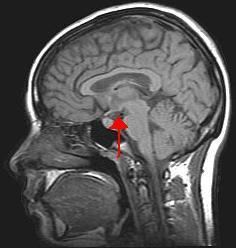 | ||
Aphagia is the inability or refusal to swallow. The word is derived from the Ancient Greek prefix α, meaning "not" or "without," and the suffix φαγία, derived from the verb φαγεῖν, meaning "to eat." It is related to dysphagia which is difficulty swallowing (Greek prefix δυσ, dys, meaning difficult, or defective), and odynophagia, painful swallowing (from ὀδύνη, odyn(o), meaning "pain"). Aphagia may be temporary or long term, depending on the affected organ. It is an extreme, life-threatening case of dysphagia. Depending on the cause, untreated dysphagia may develop into aphagia.
Contents
Behavioural aphagia
The following behavioural classifications result from studies performed on rats, in which lesions were made on the lateral hypothalamus region in the brain.
- Passive aphagia: An animal with passive aphagia will not respond to food if it is presented. However, if food is inserted into the mouth, the animal will chew.
- Active aphagia: Active aphagia is a complete rejection of food. The animal will physically push food away or move its head from it. One might first sample the food by smelling or tasting, then spit out anything in the mouth. Afterwards the animal will show a complete repulsion to the food. The animal reacts to food as if it is bitter or foul.
- Mixed aphagia: When presented with food, the animal initially does not react positively or negatively. However, when food is placed in the mouth, the animal demonstrates active aphagia, spitting out the food and refusing to eat thereafter.
These studies point to the function of the hypothalamus in regulating food intake. Animals in this study also demonstrated several other types of eating behaviour: "weak eating," in which the animal slowly approaches, chews, and swallows small observable amounts of food for a brief period; "good eating," in which the animal reaches normally for the food and eats reliably; and "vigorous eating," in which the animal gluttonously reaches for and devours the food. In these cases, there was either minor or no damage to the lateral hypothalamus.
Aphagia not classified under behavioral aphagia typically has a structural cause, see causes.
Causes
Aphagia is usually the result of many different diseases as well as different medical treatments. The most common things that can lead to aphagia are:
It is important to note that all this causes (except due to the damage of the lateral hypothalamus) are indirect causes of aphagia.
Diagnosis
Treatment and compensatory techniques
During the treatment of aphagia (or dysphagia), it is important to prodide adequate nutrition and hydration. If a person is not able to tolerate a regular diet, diet modifications and alternative means of nutrition may be considered. These include thickening liquids (typical thickening hierarchy is nectar/syrup thick, honey thick, and pudding thick) or by changing the texture of the solid foods to reduce the required amount of mastication (chewing) needed or to reduce other symptoms of oral dysphagia (such as buccal pocketing or anterior loss). Alternative means of nutrition may also be needed in more severe cases (such as when a person is deemed NPO and is not safe to eat anything orally). In these cases, nasogastric (NG) or percutaneous endoscopic gastronomy (PEG) tubes may be placed. Other compensatory measures may include reducing the bolus size (small bites/sips) or postural strategies (such as tucking the chin, turning the head to one side or the other). A speech-lanuguage pathologist is one professional who evaluates and treats aphagia and dysphagia and can recommend these strategies depending on the etiology of the deficit and the location of the breakdown within the swallowing mechanism. True treatment of aphagia/dysphagia comes from neuromuscular re-education and strengthening/coordination in most cases. This can be achieved by use of pharyngeal strengthening exercises, thermal stimulation of the swallowing trigger and oral motor exercises. In some cases, it is also appropriate to complete therapeutic exercises in conjunction with neuromuscular electrical stimulation (NMES) which utilizes low-level electrical currents to target muscle fibers from an external source (electrodes placed on the surface of the skin in strategic places to target muscles and nerves needed during the swallowing process).
